List of mammals of North America
This is a list of North American mammals. It includes all mammals currently found in North America north of Mexico, whether resident or as migrants. There is a separate list of Mexican mammals. This article does not include species found only in captivity. Mammal species which became extinct in the last 10,000 to 13,000 years are also included in this article. Each species is listed, with its binomial name. Most established introduced species occurring across multiple states and provinces are also noted.
Some species are identified as indicated below:
- (A) = Accidental: occurrence based on one or a few records, and unlikely to occur regularly
- (E) = Extinct: died out between 13,000 years ago and the present
- (Ex) = Extirpated: no longer occurs in area of interest, but other populations exist elsewhere
- (I) = Introduced: population established solely as result of direct or indirect human intervention; synonymous with non-native and non-indigenous
 |
Conservation status - IUCN Red List of Threatened Species:
- EX - extinct, EW - extinct in the wild
- CR - critically endangered, EN - endangered, VU - vulnerable
- NT - near threatened, LC - least concern
- DD - data deficient, NE - not evaluated
- (v. 2013.2, the data is current as of March 5, 2014[1])
and Endangered Species Act:
- E - endangered, T - threatened
- XN, XE - experimental non essential or essential population
- E(S/A), T(S/A) - endangered or threatened due to similarity of appearance
- (selected only taxa found in the US, the data is current as of March 28, 2014[2])
Opossums
Didelphidae
- Virginia opossum, Didelphis virginiana [n 1][n 2] LC
Armadillos
Dasypodidae
- Nine-banded armadillo, Dasypus novemcinctus [n 3] LC
- Beautiful armadillo, Dasypus bellus (E)
Chlamyphoridae
- American glyptodont, Glyptotherium floridanum (E)
Pampatheriidae
- American giant armadillo, Holmesina septentrionalis (E)
Sloths
Megatheriidae
- American giant ground sloth, Eremotherium laurillardi (E)
Mylodontidae
- Harlan's ground sloth, Paramylodon harlani (E)
Nothrotheriidae
- Shasta ground sloth, Nothrotheriops shastensis [9] (E)
Rodents
Aplodontiidae
- Mountain beaver, Aplodontia rufa [n 3] LC
- (ssp. A. r. nigra: E)
Beavers
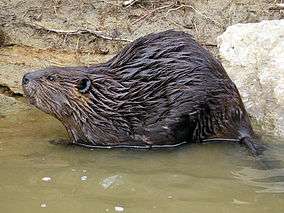
- North American beaver, Castor canadensis [n 3] LC
- Giant beaver, Castoroides ohioensis [9] (E)
Jumping mice
- Woodland jumping mouse, Napaeozapus insignis [n 3] LC
- Meadow jumping mouse, Zapus hudsonius [n 3] LC
- (Preble's meadow jumping mouse, Z. h. preblei: T)
- Western jumping mouse, Zapus princeps [n 3] LC
- Pacific jumping mouse, Zapus trinotatus [n 3] LC
Porcupines
- North American porcupine, Erethizon dorsatum [n 3] LC
Capybaras
- North American capybara, Neochoerus pinckneyi (E)
- Holmes's capybara, Neochoerus aesopi (E)
Geomyidae
There has been much debate among taxonomists about which races of pocket gopher should be recognized as full species, and the following list cannot be regarded as definitive.
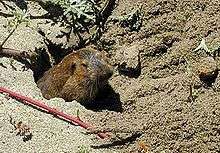
- Yellow-faced pocket gopher, Cratogeomys castanops [n 3] LC
- Desert pocket gopher, Geomys arenarius [n 1][n 4] NT
- Attwater's pocket gopher, Geomys attwateri [n 1] LC
- Baird's pocket gopher, Geomys breviceps [n 1] LC
- Plains pocket gopher, Geomys bursarius [n 3][n 5] LC
- Knox Jones's pocket gopher, Geomys knoxjonesi [n 1] LC
- Texas pocket gopher, Geomys personatus [n 6] LC
- Southeastern pocket gopher, Geomys pinetis [n 3] LC
- Llano pocket gopher, Geomys texensis [n 1] LC
- Botta's pocket gopher, Thomomys bottae [n 7] LC
- Camas pocket gopher, Thomomys bulbivorus [n 3] LC
- Wyoming pocket gopher, Thomomys clusius [n 1] LC
- Idaho pocket gopher, Thomomys idahoensis [n 1] LC
- Mazama pocket gopher, Thomomys mazama [n 3] LC
- Mountain pocket gopher, Thomomys monticola [n 3] LC
- Northern pocket gopher, Thomomys talpoides [n 3] LC
- Townsend's pocket gopher, Thomomys townsendii [n 3] LC
- Southern pocket gopher, Thomomys umbrinus [n 3] LC
Heteromyidae

- Mexican spiny pocket mouse, Liomys irroratus [n 3] LC
- Ord's kangaroo rat, Dipodomys ordii [n 3] LC
- Gulf Coast kangaroo rat, Dipodomys compactus [n 1] LC
- Chisel-toothed kangaroo rat, Dipodomys microps [n 3] LC
- Panamint kangaroo rat, Dipodomys panamintinus [n 3] LC
- Stephens's kangaroo rat, Dipodomys stephensi [n 3] EN E
- Narrow-faced kangaroo rat, Dipodomys venustus [n 3] [n 8] LC
- Big-eared kangaroo rat, Dipodomys (venustus) elephantinus [n 9][n 8]
- Agile kangaroo rat, Dipodomys agilis [n 3] LC
- Heermann's kangaroo rat, Dipodomys heermanni [n 3] LC
- (Morro Bay kangaroo rat, D. h. morroensis: E)
- California kangaroo rat, Dipodomys californicus [n 1] LC
- Giant kangaroo rat, Dipodomys ingens [n 3] EN E
- Banner-tailed kangaroo rat, Dipodomys spectabilis [n 3] NT
- Texas kangaroo rat, Dipodomys elator [n 3] VU
- Merriam's kangaroo rat, Dipodomys merriami [n 3] LC
- (San Bernardino kangaroo rat, D. m. parvus: E)
- Fresno kangaroo rat, Dipodomys nitratoides [n 3] VU
- (Fresno subspecies D. n. exilis and Tipton kangaroo rat, D. n. nitratoides: E)
- Desert kangaroo rat, Dipodomys deserti [n 3] LC
- Dulzura kangaroo rat, Dipodomys simulans [n 1] LC
- Dark kangaroo mouse, Microdipodops megacephalus [n 3] LC
- Pale kangaroo mouse, Microdipodops pallidus [n 3] LC
- White-eared pocket mouse, Perognathus alticola [n 3] EN
- Arizona pocket mouse, Perognathus amplus [n 3] LC
- Olive-backed pocket mouse, Perognathus fasciatus [n 3] LC
- Plains pocket mouse, Perognathus flavescens [n 7] LC
- Silky pocket mouse, Perognathus flavus [n 3] LC
- San Joaquin pocket mouse, Perognathus inornatus [n 3] LC
- Little pocket mouse, Perognathus longimembris [n 3] LC
- (Pacific pocket mouse, P. l. pacificus: E)
- Merriam's pocket mouse, Perognathus merriami [n 3] LC
- Great Basin pocket mouse, Perognathus parvus [n 7] LC
- Bailey's pocket mouse, Chaetodipus baileyi [n 3] LC
- California pocket mouse, Chaetodipus californicus [n 3] LC
- Chihuahuan pocket mouse, Chaetodipus eremicus [n 1] LC
- San Diego pocket mouse, Chaetodipus fallax [n 3] LC
- Long-tailed pocket mouse, Chaetodipus formosus [n 3] LC
- Hispid pocket mouse, Chaetodipus hispidus [n 3] LC
- Rock pocket mouse, Chaetodipus intermedius [n 3] LC
- Nelson's pocket mouse, Chaetodipus nelsoni [n 3] LC
- Desert pocket mouse, Chaetodipus penicillatus [n 3] LC
- Spiny pocket mouse, Chaetodipus spinatus [n 3] LC
- Baja pocket mouse, Chaetodipus rudinoris [n 10] LC
Squirrels



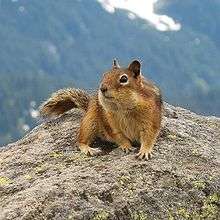
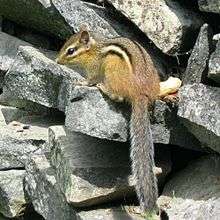
- Eastern gray squirrel, Sciurus carolinensis [n 3] LC
- Eastern fox squirrel, Sciurus niger [n 3] LC
- (Delmarva fox squirrel, S. n. cinereus: E)
- Mexican fox squirrel, Sciurus nayaritensis [n 11] LC
- Arizona gray squirrel, Sciurus arizonensis [n 3] DD
- Western gray squirrel, Sciurus griseus [n 3] LC
- Mexican gray squirrel, Sciurus aureogaster [n 12] LC
- American red squirrel, Tamiasciurus hudsonicus [n 3] LC
- (Mount Graham red squirrel, T. h. grahamensis: E)
- Douglas squirrel, Tamiasciurus douglasii [n 3] LC
- Abert's squirrel, Sciurus aberti [n 3] LC
- Northern flying squirrel, Glaucomys sabrinus [n 3] LC
- (Carolina northern flying squirrel G. s. coloratus and Virginia northern flying squirrel G. s. fuscus: E)
- Southern flying squirrel, Glaucomys volans [n 3] LC
- Humboldt's flying squirrel, Glaucomys oregonensis
- Harris's antelope squirrel, Ammospermophilus harrisii [n 3] LC
- San Joaquin antelope squirrel, Ammospermophilus nelsoni [n 3] EN
- White-tailed antelope squirrel, Ammospermophilus leucurus [n 3][n 13] LC
- Texas antelope squirrel, Ammospermophilus interpres [n 1][n 4] LC
- Gunnison's prairie dog, Cynomys gunnisoni [n 3][n 5] LC
- White-tailed prairie dog, Cynomys leucurus [n 1][n 4] LC
- Black-tailed prairie dog, Cynomys ludovicianus [n 3] LC
- Utah prairie dog, Cynomys parvidens [n 1][n 4] EN T
- Alaska marmot, Marmota broweri [n 1] LC
- Hoary marmot, Marmota caligata [n 3] LC
- Yellow-bellied marmot, Marmota flaviventris [n 3] LC
- Woodchuck, Marmota monax [n 3] LC
- Olympic marmot, Marmota olympus [n 3] LC
- Vancouver Island marmot, Marmota vancouverensis [n 3] CR E
- California ground squirrel, Otospermophilus beecheyi [n 3] LC
- Rock squirrel, Otospermophilus variegatus [n 3] LC
- Golden-mantled ground squirrel, Callospermophilus lateralis [n 3][n 5] LC
- Cascade golden-mantled ground squirrel, Callospermophilus saturatus [n 1][n 4] LC
- Mohave ground squirrel, Xerospermophilus mohavensis [n 3] VU
- Spotted ground squirrel, Xerospermophilus spilosoma [n 3] LC
- Round-tailed ground squirrel, Xerospermophilus tereticaudus [n 3] LC
- Franklin's ground squirrel, Poliocitellus franklinii [n 3] LC
- Mexican ground squirrel, Ictidomys mexicanus [n 3] LC
- Thirteen-lined ground squirrel, Ictidomys tridecemlineatus [n 3] LC
- Uinta ground squirrel, Urocitellus armatus [n 3] LC
- Belding's ground squirrel, Urocitellus beldingi [n 3] LC
- Northern Idaho ground squirrel, Urocitellus brunneus [n 3] CR
- Southern Idaho ground squirrel, Urocitellus endemicus [n 3] VU
- Columbian ground squirrel, Urocitellus columbianus [n 3] LC
- Wyoming ground squirrel, Urocitellus elegans [n 1] LC
- Arctic ground squirrel, Urocitellus parryii [n 3] LC
- Richardson's ground squirrel, Urocitellus richardsonii [n 3] LC
- Townsend's ground squirrel, Urocitellus townsendii [n 3] VU
- Merriam's ground squirrel, Urocitellus canus [n 1] LC
- Piute ground squirrel, Urocitellus mollis [n 1][10] LC
- Townsend's ground squirrel, Urocitellus (townsendii) nancyae [11] VU
- Washington ground squirrel, Urocitellus washingtoni [n 3] NT
- Alpine chipmunk, Tamias alpinus [n 3] LC
- Yellow pine chipmunk, Tamias amoenus [n 3] LC
- Gray-footed chipmunk, Tamias canipes [n 1] LC
- Gray-collared chipmunk, Tamias cinereicollis [n 3] LC
- Cliff chipmunk, Tamias dorsalis [n 3] LC
- Merriam's chipmunk, Tamias merriami [n 3] LC
- Least chipmunk, Tamias minimus [n 3] LC
- California chipmunk, Tamias obscurus [n 1] LC
- Yellow-cheeked chipmunk, Tamias ochrogenys [n 1] LC
- Palmer's chipmunk, Tamias palmeri [n 3] EN
- Panamint chipmunk, Tamias panamintinus [n 3] LC
- Long-eared chipmunk, Tamias quadrimaculatus [n 3] LC
- Colorado chipmunk, Tamias quadrivittatus [n 3] LC
- Red-tailed chipmunk, Tamias ruficaudus [n 3] LC
- Hopi chipmunk, Tamias rufus [n 1] LC
- Allen's chipmunk, Tamias senex [n 1] LC
- Siskiyou chipmunk, Tamias siskiyou [n 1] LC
- Sonoma chipmunk, Tamias sonomae [n 3] LC
- Lodgepole chipmunk, Tamias speciosus [n 3] LC
- Eastern chipmunk, Tamias striatus [n 3] LC
- Townsend's chipmunk, Tamias townsendii [n 3] LC
- Uinta chipmunk, Tamias umbrinus [n 3] LC
Muroidea
There has been much debate among taxonomists about which races of mice and voles should be recognized as full species, and the following list cannot be regarded as definitive.
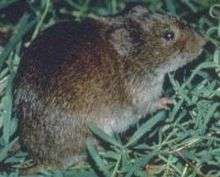

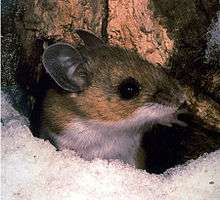
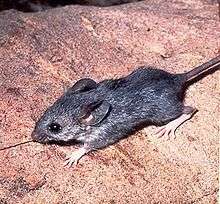
- Insular vole, Microtus abbreviatus [n 3] LC
- Beach vole, Microtus breweri [n 14][n 4] VU
- California vole, Microtus californicus [n 3] LC
- (ssp. scirpen: E)
- Gray-tailed vole, Microtus canicaudus [n 1] LC
- Rock vole, Microtus chrotorrhinus [n 3] LC
- Long-tailed vole, Microtus longicaudus [n 7] LC
- Mexican vole, Microtus mexicanus [n 15] LC
(including M. mogollonensis: LC, ssp. hualpaiensis: E)- Mogollon vole, Microtus mogollonensis [n 15] (sometimes split from Microtus mexicanus)
- Singing vole, Microtus miurus [n 3] LC
- Montane vole, Microtus montanus [n 3] LC
- Prairie vole, Microtus ochrogaster [n 3] LC
- Tundra vole, Microtus oeconomus [n 3] LC
- Creeping vole, Microtus oregoni [n 3] LC
- Meadow vole, Microtus pennsylvanicus [n 3][n 5] LC **(Florida salt marsh vole M. p. dukecampbelli: E)
- Woodland vole, Microtus pinetorum [n 3] LC
- Water vole, Microtus richardsoni [n 3] LC
- Townsend's vole, Microtus townsendii [n 3] LC
- Taiga vole, Microtus xanthognathus [n 3] LC
- Sagebrush vole, Lemmiscus curtatus [n 3] LC
- Muskrat, Ondatra zibethicus [n 3] LC
- White-footed vole, Arborimus albipes [n 3] LC
- Red tree vole, Arborimus longicaudus [n 3] NT
- California red tree mouse, Arborimus pomo [n 1] NT
- Western heather vole, Phenacomys intermedius [n 3] LC
- Eastern heather vole, Phenacomys ungava [n 1] LC
- Western red-backed vole, Myodes californicus [n 3] LC
- Southern red-backed vole, Myodes gapperi [n 7] LC
- Northern red-backed vole, Myodes rutilus [n 3] LC
- Northern bog lemming, Synaptomys borealis [n 3] LC
- Southern bog lemming, Synaptomys cooperi [n 3] LC
- Brown lemming, Lemmus trimucronatus [n 3] LC
- Round-tailed muskrat, Neofiber alleni [n 3] LC
- Northern collared lemming, Dicrostonyx groenlandicus [n 16] LC
- Ungava collared lemming, Dicrostonyx hudsonius [n 3] LC
- Richardson's collared lemming, Dicrostonyx richardsoni [n 1] LC
- Nelson's collared lemming, Dicrostonyx nelsoni [n 17] LC
- Ogilvie Mountains collared lemming, Dicrostonyx nunatakensis [n 18] LC
- Unalaska collared lemming, Dicrostonyx unalascensis [n 18] DD
- White-throated woodrat, Neotoma albigula [n 3] LC
- Bushy-tailed woodrat, Neotoma cinerea [n 3] LC
- Arizona woodrat, Neotoma devia [n 1] LC
- Eastern woodrat, Neotoma floridana [n 3] LC
- (Key Largo woodrat, N. f. smalli: E)
- Dusky-footed woodrat, Neotoma fuscipes [n 3] LC
- (ssp. riparia: E)
- Desert woodrat, Neotoma lepida [n 3] LC
- Bryant's woodrat, Neotoma bryanti [15] LC
- Allegheny woodrat, Neotoma magister [n 1] NT
- Mexican woodrat, Neotoma mexicana [n 3] LC
- Southern Plains woodrat, Neotoma micropus [n 3] LC
- Stephen's woodrat, Neotoma stephensi [n 3] LC
- White-toothed woodrat, Neotoma leucodon [n 10] LC
- Big-eared woodrat, Neotoma macrotis [n 10] LC
- Northern pygmy mouse, Baiomys taylori [n 3] LC
- Golden mouse, Ochrotomys nuttalli [n 3] LC
- California mouse, Peromyscus californicus [n 3] LC
- Cactus mouse, Peromyscus eremicus [n 3] LC
- Northern Baja deer mouse, Peromyscus fraterculus [n 10] LC
- Mesquite mouse, Peromyscus merriami [n 3] LC
- Canyon mouse, Peromyscus crinitus [n 3] LC
- Deer mouse, Peromyscus maniculatus [n 3] LC
- Oldfield mouse, Peromyscus polionotus [n 3] LC
- (Choctawatchee beach mouse, P. p. allophrys, Perdido Key beach mouse, P. p. trissyllepsis, St. Andrews beach mouse, P. p. peninsularis, Alabama beach mouse, P. p. ammobates and Anastasia Island beach mouse, P. p. phasma: E, Southeastern beach mouse, P. p. niveiventris: T)
- White-footed mouse, Peromyscus leucopus [n 3] LC
- Cotton mouse, Peromyscus gossypinus [n 3] LC
- (ssp. allapaticola: E)
- Brush mouse, Peromyscus boylii [n 3] LC
- Texas mouse, Peromyscus attwateri [n 1] LC
- White-ankled mouse, Peromyscus pectoralis [n 3] LC
- Pinyon mouse, Peromyscus truei [n 3] LC
- Osgood's mouse, Peromyscus gratus [n 1] LC
- Northwestern deer mouse, Peromyscus keeni [n 3] LC
- Northern rock mouse, Peromyscus nasutus [n 1][n 19] LC
- Black-eared mouse, Peromyscus melanotis [n 18] LC
- Peromyscus anayapahensis [16] (E)
- Peromyscus nesodytes [16] (E)
- Fulvous harvest mouse, Reithrodontomys fulvescens [n 3] LC
- Eastern harvest mouse, Reithrodontomys humulis [n 3] LC
- Western harvest mouse, Reithrodontomys megalotis [n 3] LC
- Plains harvest mouse, Reithrodontomys montanus [n 3] LC
- Salt marsh harvest mouse, Reithrodontomys raviventris [n 3] EN E
- Mearn's grasshopper mouse, Onychomys arenicola [n 1] LC
- Northern grasshopper mouse, Onychomys leucogaster [n 3] LC
- Southern grasshopper mouse, Onychomys torridus [n 3] LC
- Florida mouse, Podomys floridanus [n 3] VU
- Hispid cotton rat, Sigmodon hispidus [n 3] LC
- Yellow-nosed cotton rat, Sigmodon ochrognathus [n 3] LC
- Arizona cotton rat, Sigmodon arizonae [n 1] LC
- Tawny-bellied cotton rat, Sigmodon fulviventer [n 3] LC
- Coues's rice rat, Oryzomys couesi [n 1] LC
- Marsh rice rat, Oryzomys palustris [n 3][n 20] LC
- (ssp. natator: E)
Rabbits and hares
Leporidae

- Pygmy rabbit, Brachylagus idahoensis [n 3] LC E
- Brush rabbit, Sylvilagus bachmani [n 3] LC (ssp. riparius: E)
- Swamp rabbit, Sylvilagus aquaticus [n 3] LC
- Marsh rabbit, Sylvilagus palustris [n 3] LC
- (Lower Keys marsh rabbit, S. p. hefneri: E)
- Eastern cottontail, Sylvilagus floridanus [n 3] LC
- Manzano Mountain cottontail, Sylvilagus cognatus [n 21] DD (formerly in Sylvilagus floridanus)
- New England cottontail, Sylvilagus transitionalis [n 3] VU
- Mountain cottontail, Sylvilagus nuttallii [n 3] LC
- Desert cottontail, Sylvilagus audubonii [n 3] LC
- Appalachian cottontail, Sylvilagus obscurus [n 1] NT
- Robust cottontail, Sylvilagus robustus [n 22] EN
- Antelope jackrabbit, Lepus alleni [n 3][n 5] LC
- Snowshoe hare, Lepus americanus [n 3] LC
- Arctic hare, Lepus arcticus [n 3] LC
- Alaskan hare, Lepus othus [n 3] LC
- Black-tailed jackrabbit, Lepus californicus [n 3] LC
- White-sided jackrabbit, Lepus callotis [n 1][n 4] NT
- White-tailed jackrabbit, Lepus townsendii [n 3] LC
- Atzlan rabbit, Aztlanolagus agilis (E)
Ochotonidae
- Collared pika, Ochotona collaris [n 3] LC
- American pika, Ochotona princeps [n 3] LC
- Giant pika, Ochotona whartoni [16] (E)
Moles and shrews
Talpidae
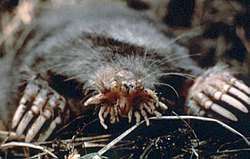
- Star-nosed mole, Condylura cristata [n 3] LC
- Hairy-tailed mole, Parascalops breweri [n 3] LC
- Eastern mole, Scalopus aquaticus [n 3] LC
- Broad-footed mole, Scapanus latimanus [n 3] LC
- Coast mole, Scapanus orarius [n 3] LC
- Townsend's mole, Scapanus townsendii [n 3] LC
- Shrew-mole, Neurotrichus gibbsii [n 3] LC
Soricidae
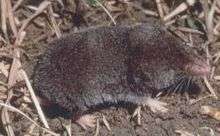
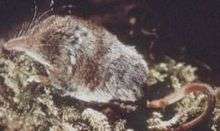
- Northern short-tailed shrew, Blarina brevicauda [n 3] LC
- Southern short-tailed shrew, Blarina carolinensis [n 1] LC
- Everglades short-tailed shrew, Blarina peninsulae [6]
- (B. carolinensis: LC)
- Elliot's short-tailed shrew, Blarina hylophaga [n 1] LC
- North American least shrew, Cryptotis parva [n 3] LC
- Cockrum's gray shrew, Notiosorex cockrumi [n 10] LC
- Crawford's gray shrew, Notiosorex crawfordi [n 3] LC
- Long-tailed shrew, Sorex dispar [n 23] LC
- Gaspé shrew, Sorex gaspensis[n 24]
- Smoky shrew, Sorex fumeus [n 3] LC
- American pygmy shrew, Sorex hoyi [n 3] LC
- Dwarf shrew, Sorex nanus [n 3] LC
- Ornate shrew, Sorex ornatus [n 7] LC (ssp. relictus: E)
- Inyo shrew, Sorex tenellus [n 3] LC
- Baird's shrew, Sorex bairdi [n 1] LC
- Marsh shrew, Sorex bendirii [n 3] LC
- New Mexico shrew, Sorex neomexicanus [n 10] DD
- Pacific shrew, Sorex pacificus [n 3] LC
- American water shrew, Sorex palustris [n 3][n 5] LC
- Fog shrew, Sorex sonomae [n 1] LC
- Vagrant shrew, Sorex vagrans [n 7] LC
- Cinereus shrew, Sorex cinereus [n 3] LC
- Olympic shrew, Sorex rohweri [n 25] LC (formerly in Sorex cinereus)
- Prairie shrew, Sorex haydeni [n 1] LC
- Saint Lawrence Island shrew, Sorex jacksoni [n 22][n 4] LC
- Southeastern shrew, Sorex longirostris [n 3] LC
- Mount Lyell shrew, Sorex lyelli [n 3] LC
- Preble's shrew, Sorex preblei [n 3] LC
- Pribilof Island shrew, Sorex pribilofensis [n 7] EN
- Barren ground shrew, Sorex ugyunak [n 1] LC
- Alaska tiny shrew, Sorex yukonicus [n 18] LC
- Arctic shrew, Sorex arcticus [n 3][n 5] LC
- Maritime shrew, Sorex maritimensis [n 10] LC
- Tundra shrew, Sorex tundrensis [n 1] LC
- Arizona shrew, Sorex arizonae [n 1] LC
- Merriam's shrew, Sorex merriami [n 3] LC
- Trowbridge's shrew, Sorex trowbridgii [n 3] LC
- Montane shrew, Sorex monticolus [n 3] LC
- Glacier Bay water shrew, Sorex alaskanus [n 26] [n 4] DD
Bats
Vespertilionidae


- Western pipistrelle, Pipistrellus hesperus [n 3] LC
- Eastern pipistrelle, Pipistrellus subflavus [n 3] LC
- Big brown bat, Eptesicus fuscus [n 3] LC
- Evening bat, Nycticeius humeralis [n 3] LC
- Desert red bat, Lasiurus blossevillii [n 14] LC
- Eastern red bat, Lasiurus borealis [n 27] LC
- Hoary bat, Lasiurus cinereus [n 3] LC
- (Hawaiian hoary bat, L. c. semotus: E)
- Southern yellow bat, Lasiurus ega [n 27] LC
- Seminole bat, Lasiurus seminolus [n 3] LC
- Northern yellow bat, Lasiurus intermedius [n 3] LC
- Western yellow bat, Lasiurus xanthinus [n 1] LC
- Allen's big-eared bat, Idionycteris phyllotis [n 3] LC
- Spotted bat, Euderma maculatum [n 3] LC
- Rafinesque's big-eared bat, Corynorhinus rafinesquii [n 3] LC
- Townsend's big-eared bat, Corynorhinus townsendii [n 3] LC
- (ssp. C. t. virginianus and C. t. ingens: E)
- Southwestern myotis, Myotis auriculus [n 1][n 28] LC
- Southeastern myotis, Myotis austroriparius [n 3] LC
- California myotis, Myotis californicus [n 3] LC
- Western small-footed myotis, Myotis ciliolabrum [n 1] LC
- Dark-nosed small-footed myotis, Myotis melanorhinus [n 29] LC
- Long-eared myotis, Myotis evotis [n 3][n 5] LC
- Gray bat, Myotis grisescens [n 3] NT E
- Keen's myotis, Myotis keenii [n 3] LC
- Eastern small-footed myotis, Myotis leibii [n 3] LC
- Little brown bat, Myotis lucifugus [n 3] LC
- Northern long-eared myotis, Myotis septentrionalis [n 1] LC
- Indiana bat, Myotis sodalis [n 3] EN E
- Fringed myotis, Myotis thysanodes [n 3] LC
- Cave myotis, Myotis velifer [n 3] LC
- Long-legged myotis, Myotis volans [n 3] LC
- Yuma myotis, Myotis yumanensis [n 3] LC
- Silver-haired bat, Lasionycteris noctivagans [n 3] LC
- Arizona myotis, Myotis occultus [n 30] LC
Molossidae
- Wagner's mastiff bat, Eumops glaucinus [n 3] LC
- Florida bonneted bat, Eumops floridanus [7] CR E (formerly in Eumops glaucinus)
- Western mastiff bat, Eumops perotis [n 3] LC
- Underwood's mastiff bat, Eumops underwoodi [n 3] LC
- Pallas's mastiff bat, Molossus molossus [n 31] LC
- Pocketed free-tailed bat, Nyctinomops femorosaccus [n 3] LC
- Big free-tailed bat, Nyctinomops macrotis [n 3] LC
- Mexican free-tailed bat, Tadarida brasiliensis [n 3] LC
Antrozoidae
- Pallid bat, Antrozous pallidus [n 3] LC
Mormoopidae
- Ghost-faced bat, Mormoops megalophylla [n 3] LC
- Pristine mustached bat, Pteronotus pristinus (E) [n 32]
Phyllostomidae
- Mexican long-tongued bat, Choeronycteris mexicana [n 3] NT
- Hairy-legged vampire bat, Diphylla ecaudata [n 3] LC
- Mexican long-nosed bat, Leptonycteris nivalis [n 3][n 13] EN E
- Lesser long-nosed bat, Leptonycteris yerbabuenae [n 33] VU
(Previously considered a subspecies of L. curasoae: L. c. yerbabuenae) - California leaf-nosed bat, Macrotus californicus [n 3][n 5] LC
- Velvety fruit-eating bat, Enchisthenes hartii [n 21] LC
Carnivores
Felines
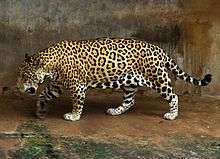
- Jaguarundi, Puma yagouaroundi [n 3] LC
- (Gulf Coast jaguarundi, P. y. cacomitli and Sinaloan jauguarundi P. y. tolteca: E)
- Ocelot, Leopardus pardalis [n 3] LC E
- Canada lynx, Lynx canadensis [n 3] LC T
- Bobcat, Lynx rufus [n 3] LC
- Mountain lion, Puma concolor [n 3] LC T(S/A) (except coryi(
- ssp. P. c. couguar and P. c. coryi: E)
- Margay, Leopardus wiedii [n 34] (Ex) NT
- Jaguar, Panthera onca [n 3] NT E
- Sabre-tooth cat, Smilodon fatalis [9] (E)
- American scimitar cat, Homotherium serum (E)
- American cheetah, Miracinonyx trumani, inexpectatus (E)
- American lion, Panthera leo atrox (E)
- Beringian cave lion, Panthera leo spelaea (E)
Canines
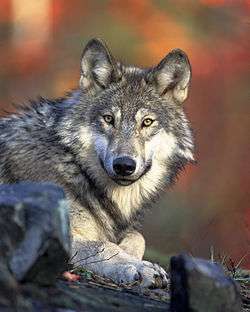
- Coyote, Canis latrans [n 3] LC
- Gray wolf, Canis lupus [n 3] LC E (and XN)
- Red wolf, Canis rufus [n 35] CR E (and XN)
- Eastern wolf, Canis lycaon [3][22][23] (Ex??)
- Dire wolf, Canis dirus [9] (E)
- Red fox, Vulpes vulpes [n 3][n 36] LC
- Swift fox, Vulpes velox [n 3] LC (ssp. hebes: E)
- Kit fox, Vulpes macrotis [n 3] LC (ssp. mutica: E)
- Arctic fox, Vulpes lagopus [n 3] LC
- Gray fox, Urocyon cinereoargenteus [n 3][n 5] LC
- Island fox, Urocyon littoralis [n 1][n 4] NT
**(ssp. U.l. littoralis, U. l. catalinae, U. l. santarosae and U. l. santacruzae: E) - Dhole, Cuon alpinus (Ex) EN E
Bears
- Brown bear, Ursus arctos [n 37] LC (includes grizzly bear, U. a. horribilis: T, XN and
Alaskan brown bear or Kodiak bear, U. a. middendorffi) - American black bear, Ursus americanus [n 3] LC T(S/A)
(Louisiana black bear U. a. luteolus: T) - Polar bear, Ursus maritimus [n 3] VU T
- Florida cave bear, Tremarctos floridanus (E)
- Short-faced bear, Arctodus simus [9] (E)
Mustelids

- Sea otter, Enhydra lutris [n 3] EN
- (ssp. E. l . nereis and E. l . kenyoni: T, ssp. E. l . nereis also XN)
- Northern river otter, Lontra canadensis [n 3] LC
- American badger, Taxidea taxus [n 3] LC
- Wolverine, Gulo gulo [n 3][n 38] LC
- American marten, Martes americana [n 3] LC
- Fisher, Martes pennanti [n 3] LC
- Ermine, Mustela erminea [n 3] LC
- Long-tailed weasel, Mustela frenata [n 3] LC
- Least weasel, Mustela nivalis [n 3][n 39] LC
- Black-footed ferret, Mustela nigripes [n 3] EN E (and XN)
- American mink, Neovison vison [n 3] LC
- Sea mink, Neovison macrodon [n 21][16] (E) EX
Mephitidae
- Striped skunk, Mephitis mephitis [n 3] LC
- Hooded skunk, Mephitis macroura [n 3] LC
- Western spotted skunk, Spilogale gracilis [n 1] LC
- Eastern spotted skunk, Spilogale putorius [n 3][n 20] LC
- Hog-nosed skunk, Conepatus leuconotus [n 40] LC (merged with western hog-nosed skunk Conepatus mesoleucus)
- Short-faced skunk, Brachyprotoma obtusata (E)
Eared seals
- Northern fur seal, Callorhinus ursinus [n 3] VU
- Guadalupe fur seal, Arctocephalus townsendi [n 3][n 41] NT T
- Steller sea lion, Eumetopias jubatus [n 3] NT
- (ssp. E. j. monteriensis: LC, ssp. E. j. jubatus: EN) T (except west of 144° W, where E)
- California sea lion, Zalophus californianus [n 3] LC
Earless seals
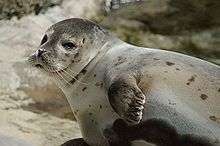
- Caribbean monk seal, Monachus tropicalis [n 42] (E) EX
- Hawaiian monk seal, Monachus schauinslandi [n 21] (Hawaiian Islands only) CR E
- Northern elephant seal, Mirounga angustirostris [n 3] LC
- Bearded seal, Erignathus barbatus [n 3] LC
- Hooded seal, Cystophora cristata [n 3] VU
- Harbor seal, Phoca vitulina [n 3] LC
- Spotted seal, Phoca largha [n 1] DD T
- Ringed seal, Pusa hispida [n 3] LC
- Harp seal, Pagophilus groenlandicus [n 3] LC
- Ribbon seal, Histriophoca fasciata [n 3] DD
- Grey seal, Halichoerus grypus [n 3] LC
Perissodactyla
Horses
- Equus species Equus sp. (E)
- Tarpan, Equus ferus ferus (E)
- Scott's horse, Equus scotti (E)
- Yukon wild horse, Equus lambei (E)
- Mexican horse, Equus conversidens [9] (E)
- Western horse, Equus occidentalis (E)
Tapirs
- Cope's tapir, Tapirus copei (E)
- California tapir, Tapirus californicus (E)
- Merriam's tapir, Tapirus merriami (E)
- Florida tapir, Tapirus veroensis (E)
Artiodactyla
Camelidae
- American camel, Camelops sp.[9] (E)
- Hemiauchenia macrocephala (E)
- Stout-legged llama, Palaeolama mirifica (E)
Tayassuidae
- Collared peccary, Pecari tajacu [n 3] LC
- Flat-headed peccary, Platygonus compressus [9] (E)
- Long-nosed peccary, Mylohyus nasutus [9] (E)
Bovines

- American bison, Bison bison [n 3] NT (Wood bison, B. b. athabascae: T)
- Ancient bison, Bison antiquus (E)
- Bison occidentalis [24] (E)
- Steppe wisent, Bison priscus (E)
- Saiga antelope, Saiga tatarica (Ex) CR
- (ssp. S. t. tatarica: CR, ssp. S. t. mongolica EN)
- Muskox, Ovibos moschatus [n 3] LC
- Harlan's muskox, Bootherium bombifrons [9] (E)
- Shrub-ox, Euceratherium collinum [9] (E)
- Mountain goat, Oreamnos americanus [n 3] LC
- Harrington's mountain goat, Oreamnos harringtoni [9] (E)
- Bighorn sheep, Ovis canadensis [n 3] LC
- (Desert bighorn sheep, O. c. nelsoni and Sierra Nevada bighorn sheep, O. c. sierrae: E)
- Dall sheep, Ovis dalli [n 3] LC
Cervidae
- Elk (wapiti) Cervus canadensis [n 43] (sometimes as C. elaphus canadensis; C. elaphus: LC)
- Caribou, Rangifer tarandus [n 44] LC
- (Migratory woodland caribou, R. t. caribou: E)
- Moose, Alces americanus [n 45] LC (sometimes as Alces alces)
- Stag-moose, Cervalces scotti [9] (E)
- Mountain deer, Navahoceros fricki (E)
- White-tailed deer, Odocoileus virginianus [n 3] LC
- (Columbian white-tailed deer, O. v. leucurus and Key deer, O. v. clavium: E)
- Mule deer, Odocoileus hemionus [n 3] LC
Antilocapridae
- Pronghorn, Antilocapra americana [n 3] LC
- (Sonoran pronghorn, A. a. sonoriensis: E)
- Dwarf pronghorn, Capromeryx minor (E)
- Shuler's pronghorn, Tetrameryx shuleri (E)
- Conkling's pronghorn, Stockoceros conklingi (E)
Delphinidae (oceanic dolphins)

- Rough-toothed dolphin, Steno bredanensis [n 27] LC
- Striped dolphin, Stenella coeruleoalba [n 27] LC
- Atlantic spotted dolphin, Stenella frontalis [n 14] DD
- Spinner dolphin, Stenella longirostris [n 27] DD
- Clymene dolphin, Stenella clymene [n 14] DD
- Pantropical spotted dolphin, Stenella attenuata [n 27] LC
- Short-beaked common dolphin, Delphinus delphis [n 27] LC
- Long-beaked common dolphin, Delphinus capensis [n 14] DD
- Common bottlenose dolphin, Tursiops truncatus [n 27] LC
- Pacific bottlenose dolphin, Tursiops (truncatus) gillii [8]
- Fraser's dolphin, Lagenodelphis hosei [n 12] LC
- Northern right whale dolphin, Lissodelphis borealis [n 27] LC
- White-beaked dolphin, Lagenorhynchus albirostris [n 27] LC
- Atlantic white-sided dolphin, Lagenorhynchus acutus [n 27] LC
- Pacific white-sided dolphin, Lagenorhynchus obliquidens [n 27] LC
- False killer whale, Pseudorca crassidens [n 27] DD
- Killer whale, Orcinus orca [n 27] DD E
- Risso's dolphin, Grampus griseus [n 27] LC
- Long-finned pilot whale, Globicephala melas [n 27] DD
- Short-finned pilot whale, Globicephala macrorhynchus [n 3] DD
- Pygmy killer whale, Feresa attenuata [n 27] DD
- Melon-headed whale, Peponocephala electra [n 14] LC
Porpoise
- Harbor porpoise, Phocoena phocoena [n 27] LC
- Dall's porpoise, Phocoenoides dalli [n 27] LC
Kogiidae
- Pygmy sperm whale, Kogia breviceps [n 27] DD
- Dwarf sperm whale, Kogia sima [n 27] (Hawaiian Islands only) DD
Physeteridae
- Sperm whale, Physeter macrocephalus [n 27] VU E
Ziphiidae (beaked whales)

- Gervais' beaked whale, Mesoplodon europaeus [n 27] DD
- Blainville's beaked whale, Mesoplodon densirostris [n 27] DD
- True's beaked whale, Mesoplodon mirus [n 27] DD
- Sowerby's beaked whale, Mesoplodon bidens [n 27] DD
- Stejneger's beaked whale, Mesoplodon stejnegeri [n 27] DD
- Ginkgo-toothed beaked whale, Mesoplodon ginkgodens [n 27] DD
- Hubbs' beaked whale, Mesoplodon carlhubbsi [n 27] DD
- Perrin's beaked whale, Mesoplodon perrini [n 22] DD
- Hector's beaked whale, Mesoplodon hectori [n 46] (A) DD
- Pygmy beaked whale, Mesoplodon peruvianus [n 47] (A) DD
- Tropical bottlenose whale, Indopacetus pacificus [7][26] DD
- Northern bottlenose whale, Hyperoodon ampullatus [n 27] DD
- Cuvier's beaked whale, Ziphius cavirostris [n 27] LC
- Giant beaked whale, Berardius bairdii [n 27] DD (collective name for two species - Baird's beaked whale and Arnoux's beaked whale)
Eschrichtiidae
- Gray whale, Eschrichtius robustus [n 27] LC E
Balaenopteridae (rorquals)
- Blue whale, Balaenoptera musculus [n 27] EN E
- (ssp. brevicauda - pygmy blue whale: DD, ssp. musculus North Pacific stock: LR/cd, ssp. musculus North Atlantic stock: VU)
- Fin whale, Balaenoptera physalus [n 27] EN E
- Sei whale, Balaenoptera borealis [n 27] EN E
- Common minke whale, Balaenoptera acutorostrata [n 27] LC
- Bryde's whale, Balaenoptera edeni [n 27] (A) DD
- Humpback whale, Megaptera novaeangliae [n 27] LC E
Balaenidae
- Bowhead whale, Balaena mysticetus [n 3] LC E (Bering-Chukchi-Beaufort Sea subpopulation: LR/cd, Svalbard-Barents Sea (Spitsbergen) subpopulation: CR)
- North Atlantic right whale, Eubalaena glacialis [n 27] EN E
- North Pacific right whale, Eubalaena japonica [n 29] (A) (Hawaiian Islands only) EN E (Northeast Pacific subpopulation: CR)
Sirenia (sea cows)
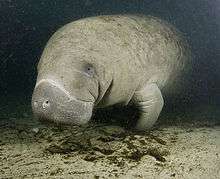
Crystal River, Florida
Trichechidae
- West Indian manatee, Trichechus manatus [n 3] VU E
- (ssp. T. m . manatus - Antillean or Caribbean manatee: EN, ssp. T. m . latirostris - Florida manatee: EN)
Proboscidea

Elephantidae
- Woolly mammoth, Mammuthus primigenius [16][27] (E)
- Columbian mammoth, Mammuthus columbi [9] (E)
- Pygmy mammoth, Mammuthus exilis [9] (E)
Mammutidae
- American mastodon, Mammut americanum [9] (E)
Introduced mammals
Muroidea
- Norway rat, Rattus norvegicus [n 49] (I) LC
- Black rat, Rattus rattus [n 49] (I) LC
- Polynesian rat, Rattus exulans [n 21][n 50] (I) LC (Hawaiian Islands only)
- House mouse, Mus musculus [n 42][n 51] (I) LC
Leporidae
- European hare, Lepus europaeus [n 52] (I) LC
- Cape hare, Lepus capensis [4] (I) LC
- European rabbit, Oryctolagus cuniculus [n 53] (Hawaiian Islands only) NT (I)
Herpestidae
- Small Asian mongoose, Herpestes javanicus [n 21] (I) (Hawaiian Islands only) LC
Mustelidae
- Beech marten, Martes foina [7] (I) LC
Equidae
- Feral horse, Equus ferus caballus [n 55] (I)
- Feral donkey (feral burro) Equus africanus asinus [n 56] (I)
Bovidae
- Nilgai, Boselaphus tragocamelus [n 58][n 59] (I) LC
- Feral cattle, Bos (primigenius) taurus [n 60] (I)
- Gemsbok, Oryx gazella [3][n 61] (I) LC
- Blackbuck, Antilope cervicapra [n 58][n 62] (I) NT
- Barbary sheep, Ammotragus lervia [n 58][n 63] (I) VU
- Feral goat, Capra aegagrus hircus [n 64] (I)
- Bezoar ibex, Capra aegagrus aegagrus [3][n 65] (I) LC
- Mouflon, Ovis orientalis [n 66] (I) VU
See also
- List of birds of North America
- List of mammals of Mexico
- Mammals of the Caribbean
- List of mammals of Central America
- List of mammals of South America
- Great American Interchange
- List of mammal genera
- Lists of mammals by region
- List of reptiles of North America
- List of amphibians of North America
- List of U.S. state mammals
- List of U.S. state birds
- List of U.S. state reptiles
- List of U.S. state amphibians
Notes
-
Baker et al. 2003,[3] Kays & Wilson 2002,[4] North American Mammals NMNH SI,[5] Mammal Species of the World (MSW3),[6] IUCN Red List.[7] - Virginia opossum, Didelphis virginiana: Burt & Grossenheider 1976 (Peterson Field Guide)[8] - as Opossum, D. marsupialis (merged Mexican, D. marsupialis and D. virginiana).
-
Baker et al. 2003,[3] Burt & Grossenheider 1976 (Peterson Field Guide),[8] Kays & Wilson 2002,[4] North American Mammals NMNH SI,[5] Mammal Species of the World (MSW3),[6] IUCN Red List.[7] - Burt & Grossenheider 1976 (Peterson Field Guide)[8] - mentioned only in the description of another species as possible split.
- Burt & Grossenheider 1976 (Peterson Field Guide)[8] - described separately as the nominative species but merged with another species.
- Texas pocket gopher, Geomys personatus: Burt & Grossenheider 1976 (Peterson Field Guide),[8] Kays & Wilson 2002,[4] North American Mammals NMNH SI,[5] Mammal Species of the World (MSW3),[6] IUCN Red List.[7]
Baker et al. 2003,[3] - as 2 distinct species: Texas Pocket Gopher G. personatus and Strecker's Pocket Gopher G. streckeri. - Baker et al. 2003,[3] Kays & Wilson 2002,[4] North American Mammals NMNH SI,[5] Mammal Species of the World (MSW3),[6] IUCN Red List.[7]
Burt & Grossenheider 1976 (Peterson Field Guide)[8] - described as the nominative species and 1 or 2 additional distinct species. - Mammal Species of the World (MSW3)[6] and IUCN Red List,[7] also probably North American Mammals NMNH SI[5] and Baker et al. 2003[3] - Dipodomys elephantinus merged with D. venustus as D. venustus elephantinus.
- Burt & Grossenheider 1976 (Peterson Field Guide),[8] Kays & Wilson 2002.[4]
- Baker et al. 2003,[3] North American Mammals NMNH SI,[5] Mammal Species of the World (MSW3),[6] IUCN Red List.[7]
- Mexican fox squirrel, Sciurus nayaritensis: Baker et al. 2003,[3] Kays & Wilson 2002,[4] North American Mammals NMNH SI,[5] Mammal Species of the World (MSW3),[6] IUCN Red List.[7]
Burt & Grossenheider 1976 (Peterson Field Guide)[8] - only as Apache fox squirrel S. apache. - Baker et al. 2003,[3] Kays & Wilson 2002,[4] IUCN Red List.[7]
- Burt & Grossenheider 1976 (Peterson Field Guide)[8] - range not clear because described separately as the nominative species but merged with another species.
- Baker et al. 2003,[3] Kays & Wilson 2002,[4] North American Mammals NMNH SI,[5] IUCN Red List.[7]
- Mexican vole, Microtus mexicanus:
Burt & Grossenheider 1976 (Peterson Field Guide),[8] Mammal Species of the World (MSW3),[6] IUCN Red List[7] - M. mexicanus.
Baker et al. 2003,[3] Kays & Wilson 2002[4] - only M. mogollonensis.
North American Mammals NMNH SI[5] - M. mexicanus listed, but only M. mexicanus mogollensis (Arizona and New Mexico) described in "Mexican Vole (Microtus mexicanus)" chapter.
IUCN Red List[7] - M. mexicanus sometimes split in two species: M. mexicanus and M. mogollonensis.[12][13]
12 subspecies are recognized, 4 occur in the USA (1991[14]), Hualapai Mexican vole M. m. hualpaiensis is listed as endangered (E) under the Endangered Species Act.[2][14] - Northern collared lemming, Dicrostonyx groenlandicus: Kays & Wilson 2002,[4] North American Mammals NMNH SI,[5] Mammal Species of the World (MSW3),[6] IUCN Red List.[7]
Baker et al. 2003[3] - as 3 distinct species: Peary Land collared lemming D. groenlandicus, Bering collared lemming D. rubricatus and Victoria collared lemming D. kilangmiutak
Burt & Grossenheider 1976 (Peterson Field Guide),[8] - described separately as the nominative species but merged with D. exsul. - Nelson's collared lemming, Dicrostonyx nelsoni: Mammal Species of the World (MSW3),[6] IUCN Red List.[7]
Baker et al. 2003[3] - as 2 distinct species: Nelson's collared lemming D. nelsoni and St. Lawrence Island collared lemming D. exsul.
Burt & Grossenheider 1976 (Peterson Field Guide),[8] - mentioned only in the description of D. groenlandicus as possible split (D. exsul). - Baker et al. 2003,[3] Mammal Species of the World (MSW3),[6] IUCN Red List.[7]
- Northern rock mouse, Peromyscus nasutus: Burt & Grossenheider 1976 (Peterson Field Guide)[8] - mentioned only in the description of rock mouse, Peromyscus difficilis that P. difficilis was formerly known as P. nasuts, so range is not clear because these species are merged here.
- Burt & Grossenheider 1976 (Peterson Field Guide)[8] - described separately as the nominative species but probably merged with another species.
- Mammal Species of the World (MSW3),[6] IUCN Red List.[7]
- Baker et al. 2003,[3] North American Mammals NMNH SI,[5] IUCN Red List.[7]
- Long-tailed shrew, Sorex dispar: IUCN Red List.[7]
Baker et al. 2003,[3] Burt & Grossenheider 1976 (Peterson Field Guide),[8] Kays & Wilson 2002,[4] Mammal Species of the World (MSW3),[6] North American Mammals NMNH SI[5]
- as 2 distinct species: longtail/long-tailed shrew S. dispar and Gaspé shrew S. gaspensis. - Gaspé shrew, Sorex gaspensis: Baker et al. 2003,[3] Burt & Grossenheider 1976 (Peterson Field Guide),[8] Kays & Wilson 2002,[4] Mammal Species of the World (MSW3),[6] North American Mammals NMNH SI[5]
- North American Mammals NMNH SI,[5] IUCN Red List.[7]
- Baker et al. 2003,[3] IUCN Red List.[7]
- Baker et al. 2003,[3] Burt & Grossenheider 1976 (Peterson Field Guide),[8] Kays & Wilson 2002,[4] North American Mammals NMNH SI,[5] IUCN Red List.[7]
- Southwestern myotis, Myotis auriculus: Burt & Grossenheider 1976 (Peterson Field Guide)[8] - mentioned only in the description of long-eared myotis, M. evotis as possible split, occurring in southern N. Mexico.
- North American Mammals NMNH SI,[5] Mammal Species of the World (MSW3),[6] IUCN Red List.[7]
- Baker et al. 2003,[3] Burt & Grossenheider 1976 (Peterson Field Guide),[8] North American Mammals NMNH SI,[5] Mammal Species of the World (MSW3),[6] IUCN Red List.[7]
- Velvety free-tailed bat: Baker et al. 2003,[3] North American Mammals NMNH SI,[5] Mammal Species of the World (MSW3),[6] IUCN Red List.[7]
Kays & Wilson 2002[4] - it is believed that colonies found in buildings in the Florida Keys were members of Molossidae. - Prinstine mustached bat: Mammal Species of the World (MSW3)[6] - possibly Florida.
Extinct at the end of Pleistocene - in the USA found in Rancholabrean cave deposits in southern Florida (Monkey Jungle Hammock).[19] - Lesser long-nosed bat, Leptonycteris yerbabuenae: Kays & Wilson 2002,[4] North American Mammals NMNH SI,[5] Mammal Species of the World (MSW3),[6] IUCN Red List.[7]
Baker et al. 2003[3] - as southern long-nosed bat L. curasoae (L. yerbabuenae was included[20] in L. curasoae as a subspecies[21]).
Burt & Grossenheider 1976 (Peterson Field Guide)[8] - mentioned only in the description of L. nivalis under the junior synonym[20] L. sanborni as possible split, so range is not clear here. - Margay: Baker et al. 2003,[3] Burt & Grossenheider 1976 (Peterson Field Guide),[8] Mammal Species of the World (MSW3).[6]
Kays & Wilson 2002:[4] last record in Texas from 1852.[4] - Baker et al. 2003,[3] Burt & Grossenheider 1976 (Peterson Field Guide),[8] IUCN Red List.[7]
- Red fox, Vulpes vulpes: Burt & Grossenheider 1976 (Peterson Field Guide)[8] - as North American V. fulva distinct from the Old World species V. vulpes.
- Brown bear, Ursus arctos: Baker et al. 2003,[3] Kays & Wilson 2002,[4] North American Mammals NMNH SI,[5] Mammal Species of the World (MSW3),[6] IUCN Red List.[7]
Burt & Grossenheider 1976 (Peterson Field Guide)[8] - as 2 distinct species: grizzly bear, U. horribilis and Kodiak bear, U. middendorffi, also distinct from the "worldwide" species U. arctos. - Wolverine, Gulo gulo: Burt & Grossenheider 1976 (Peterson Field Guide)[8] - as North American G. luscus distinct from the Old World species G. gulo.
- Least weasel, Mustela nivalis: Burt & Grossenheider 1976 (Peterson Field Guide)[8] - as North American M. rixosa distinct from the Old World species M. nivalis.
- American hog-nosed skunk, Conepatus leuconotus: Baker et al. 2003,[3] Burt & Grossenheider 1976 (Peterson Field Guide),[8] North American Mammals NMNH SI,[5] Mammal Species of the World (MSW3),[6] IUCN Red List.[7]
Kays & Wilson 2002[4] - as 2 distinct species: eastern hog-nosed skunk C. leuconotus and western hog-nosed skunk C. mesoleucus. - Guadalupe fur seal, Arctocephalus townsendi: Burt & Grossenheider 1976 (Peterson Field Guide)[8] - as Guadalupe fur seal A. philippi, formerly A. townsendi.
- Baker et al. 2003,[3] Burt & Grossenheider 1976 (Peterson Field Guide),[8] Kays & Wilson 2002,[4] Mammal Species of the World (MSW3),[6] IUCN Red List.[7]
- Elk, Cervus canadensis: Baker et al. 2003,[3] Burt & Grossenheider 1976 (Peterson Field Guide),[8] North American Mammals NMNH SI[5] (species list from the database).
Kays & Wilson 2002,[4] North American Mammals NMNH SI[5] (Field Guide), Mammal Species of the World (MSW3),[6] IUCN Red List[7] - as "worldwide" C. elaphus (not North American C. canadensis.) - Caribou, Rangifer tarandus: Baker et al. 2003,[3] Kays & Wilson 2002,[4] North American Mammals NMNH SI,[5] Mammal Species of the World (MSW3),[6] IUCN Red List.[7]
Burt & Grossenheider 1976 (Peterson Field Guide)[8] - as 3 distinct species: woodland caribou, R. caribou, barren-ground caribou, R. arcticus and Greenland caribou R. tarandus. - Moose, Alces americanus: North American Mammals NMNH SI,[5] Mammal Species of the World (MSW3),[6] - as North American A. americanus (distinct from Eurasian elk A. alces).
Alces alces: IUCN Red List,[7] Burt & Grossenheider 1976 (Peterson Field Guide),[8] Kays & Wilson 2002.[4] - Kays & Wilson 2002,[4] IUCN Red List.[7]
- Pygmy beaked whale: Kays & Wilson 2002:[4] one record in North America, Division of Mammals Collections NMNH SI:[25] two strandings in California (2001 and 2012).
- Baker et al. 2003,[3] Burt & Grossenheider 1976 (Peterson Field Guide),[8] Kays & Wilson 2002,[4] IUCN Red List.[7]
- Baker et al. 2003,[3] Burt & Grossenheider 1976 (Peterson Field Guide),[8] Kays & Wilson 2002.[4]
- Polynesian rat[28][29]
- House mouse: Baker et al. 2003,[3] Burt & Grossenheider 1976 (Peterson Field Guide),[8] Kays & Wilson 2002,[4] IUCN Red List.[7]
Mammal Species of the World (MSW3)[6] - only general range description. - Baker et al. 2003,[3] Burt & Grossenheider 1976 (Peterson Field Guide),[8] Mammal Species of the World (MSW3),[6] IUCN Red List.[7]
- European rabbit: Baker et al. 2003.[3]
Kays & Wilson 2002[4] - range not clear (islands on Pacific Coast).
Introduced to Hawaii.[30] - Baker et al. 2003[3] - Feral dog, Canis familiaris, Kays & Wilson 2002[4] - packs of feral domestic dogs C. familiaris.
- Baker et al. 2003[3] - Feral horse, Equus caballus, Mammal Species of the World (MSW3)[6] - Horse Equus ferus - feral.
- Baker et al. 2003,[3] Mammal Species of the World (MSW3).[6]
- Sus scrofa: Baker et al. 2003[3] - feral pig or wild boar, Burt & Grossenheider 1976 (Peterson Field Guide)[8] - wild boar (Swine), Kays & Wilson 2002[4] - wild boar, Mammal Species of the World (MSW3)[6] - wild boar - feral populations, IUCN Red List[7] - wild boar - introduced.
- Baker et al. 2003,[3] Kays & Wilson 2002,[4] Mammal Species of the World (MSW3),[6] IUCN Red List.[7]
- Nilgai - semi-free-ranging[42]/free-ranging.[43]
- Feral cattle: Baker et al. 2003[3] - domestic cattle Bos taurus, Mammal Species of the World (MSW3)[6] - aurochs, B. taurus - feral populations.
For example feral cattle in Hawaii.[44][45] - Gemsbok - free ranging.[46][47]
- Blackbuck - free ranging.[42][43][47][48]
- Barbary sheep - free ranging.[42][43]
- Feral goat: Baker et al. 2003[3] - goat Capra hircus, Mammal Species of the World (MSW3)[6] - goat C. hircus - feral populations (USA).
Goat - free-ranging, Hawaii.[49] - Bezoar ibex - free-ranging: Florida Mountains near Deming New Mexico.[47]
- Mouflon: Baker et al. 2003[3] - European mouflon sheep Ovis aries, Mammal Species of the World (MSW3)[6] - red sheep Ovis aries - mouflon introduced, improved domestic stock feral.
Feral sheep - free-ranging - Hawaii[49] and Texas.[50] - Red deer, elaphus division (not canadensis division) - introduced i.e. to USA.[6]
- Chital - free-ranging.[42]
- Sambar - free ranging.[43]
- Species listed in Baker et al. 2003, but omitted in this article: European ferret, Mustela putorius, Himalayan tahr, Hemitragus jemlahicus.
References
- "The IUCN Red List of Threatened Species". International Union for Conservation of Nature and Natural Resources. Retrieved 5 March 2014.
- "Title 50: Wildlife and Fisheries, § 17.11 Endangered and threatened wildlife". US Government Printing Office. Retrieved March 28, 2014.
- Robert J. Baker; Lisa C. Bradley; Robert D. Bradley; Jerry W. Dragoo; Mark D. Engstrom; Robert S. Hoffmann; Cheri A. Jones; Fiona Reid; Dale W. Rice & Clyde Jones (1 December 2003). "Revised checklist of North American mammals north of Mexico, 2003" (PDF). Occasional Papers. Museum of Texas Tech University (229). ISSN 0149-175X. Retrieved 9 March 2014.
- Kays, Roland W.; Wilson, Don E. (2002). Mammals of North America. Illustrated by Sandra Doyle, Nancy Halliday, Ron Klingner, Elizabeth McClelland, Consie Powell, Wendy Smith, Todd Zalewski, Diane Gibbons, Susan C. Morse, Jesse Guertin. Princeton and Oxford: Princeton University Press. ISBN 0-691-07012-1.
- "North American Mammals". Smithsonian Institution. National Museum of Natural History. Retrieved 1 April 2014.
This site is based on The Smithsonian Book of North American Mammals, by Don E. Wilson and Sue Ruff (Smithsonian Institution Press, 1999) and Mammals of North America, by Roland W. Kays and Don E. Wilson (Princeton University Press, 2002).
Downloaded on 25 March 2014 -
- Wilson, D. E.; Reeder, D. M. (eds.). Mammal Species of the World (3rd ed.). Johns Hopkins University Press. ISBN 0-8018-8221-4.
- "Search Results: Mammalia North America 2014-03-29". IUCN Red List of Threatened Species. Version 2013.2. IUCN. 2013. Retrieved 1 April 2014.
Search terms Search by taxonomy: Mammalia, Search by location: North America, (Native, Introduced, Vagrant, Uncertain), Refinements : [X] Show regional assessments:, Taxa to show: Species, Subspecies and varieties, Stocks and subpopulation. Downloaded on 29 March 2014
- Burt, William Henry (Text and Maps); Grossenheider, Richard Philip (Illustrations) (1976). A Field Guide to the Mammals. North America north of Mexico. Peterson Field Guides (Third ed.). Boston, New York: Houghton Mifflin Company. ISBN 0-395-91098-6.
- Haynes, Gary (ed.). American Megafaunal Extinctions at the End of the Pleistocene (Vertebrate Paleobiology and Paleoanthropology). Springer Science + Business Media B. V. ISBN 978-1402087929. Retrieved 2014-04-11.
- Yensen, E. 2019. Urocitellus mollis . The IUCN Red List of Threatened Species 2019: e.T116989381A116989399. Downloaded on 12 December 2019.
- Yensen, E. 2019. Urocitellus nancyae . The IUCN Red List of Threatened Species 2019: e.T116989724A116989738. Downloaded on 12 December 2019.
- Álvarez-Castañeda, S.T. & Reid, F. (2008). "Microtus mexicanus". IUCN Red List of Threatened Species. 2008. Retrieved 2 April 2014.CS1 maint: ref=harv (link)
- Musser, G.G.; Carleton, M.D. (2005). "Microtus (see comments) mexicanus". In Wilson, D.E.; Reeder, D.M (eds.). Mammal Species of the World: A Taxonomic and Geographic Reference (3rd ed.). Johns Hopkins University Press. pp. 894–1531. ISBN 978-0-8018-8221-0. OCLC 62265494.
- U.S. Fish and Wildlife Service (1991). Hualpai Mexican Vole Recovery Plan (PDF). Albuquerque, New Mexico. pp. 28 pp. Retrieved 2014-04-02.
- Álvarez-Castañeda, S.T., Lacher, T. & Vázquez, E. (2017). "Neotoma bryanti". IUCN Red List of Threatened Species. 2017: e.T117189944A22371413. doi:10.2305/IUCN.UK.2017-3.RLTS.T117189944A22371413.en. Retrieved 16 January 2018.CS1 maint: multiple names: authors list (link)
- Turvey, Samuel T. (May 28, 2009). Holocene Extinctions. Oxford New York: Oxford University Press. ISBN 978-0199535095. Retrieved 2014-04-11.
- Whitaker, John O.; Hamilton, William John (1998-06-28). Mammals of the Eastern United States (3rd ed.). Cornell University Press. ISBN 9780801434754. Retrieved 2 April 2014.
- Hutterer, R. (2005). "Sorex (Otisorex) cinereus". In Wilson, D.E.; Reeder, D.M (eds.). Mammal Species of the World: A Taxonomic and Geographic Reference (3rd ed.). Johns Hopkins University Press. pp. 220–311. ISBN 978-0-8018-8221-0. OCLC 62265494.
- Morgan, Gary S.; Emslie, Steven D. (2010). "Tropical and western influences in vertebrate faunas from the Pliocene and Pleistocene of Florida" (PDF). Quaternary International. 217: 143–158. doi:10.1016/j.quaint.2009.11.030. Retrieved 11 April 2014.
- Simmons, N.B. (2005). "Leptonycteris yerbabuenae". In Wilson, D.E.; Reeder, D.M (eds.). Mammal Species of the World: A Taxonomic and Geographic Reference (3rd ed.). Johns Hopkins University Press. pp. 312–529. ISBN 978-0-8018-8221-0. OCLC 62265494.
- Arroyo-Cabrales, J.; Miller, B.; Reid, F.; Cuarón, A.D. & de Grammont, P.C. (2008). "'Leptonycteris yerbabuenae'". IUCN Red List of Threatened Species. 2008. Retrieved 8 April 2014.CS1 maint: ref=harv (link)
- "WolfQuest. Eastern Timber Wolf (Canis lups lycaon)". Minnesota Zoo & Eduweb. Retrieved 2 April 2014.
- Mech, L.D. (2010). "What is the taxonomic identity of Minnesota wolves?" (PDF). Can. J. Zool. NRC Research Press (88): 129–138. doi:10.1139/Z09-129. Retrieved 2 April 2014.
- Hall, Stephen Austin (Aug 1972). "Holocene Bison occidentalis from Iowa". Journal of Mammalogy. 53 (3): 604–606. JSTOR 1379052.
- "Search the Division of Mammals Collections".
Keywords: Mesoplodon peruvianus: STR 13453 Stranding, Skull, Salinas State Beach, Monterey Bay, California, 2001, STR 18334: Stranding, Photograph, Arcata, Humboldt County, California, 2012
- Taylor, B.L.; Baird, R.; Barlow, J.; Dawson, S.M.; Ford, J.; Mead, J.G.; Notarbartolo di Sciara, G.; Wade, P. & Pitman, R.L. (2008). "Indopacetus pacificus". IUCN Red List of Threatened Species. 2008: e.T40635A10345818. doi:10.2305/IUCN.UK.2008.RLTS.T40635A10345818.en. Retrieved 16 January 2018.
- Crossen, K. S. (2005). "5,700-Year-Old Mammoth Remains from the Pribilof Islands, Alaska: Last Outpost of North America Megafauna". Geological Society of America. 37: 463. Archived from the original on 5 September 2018. Retrieved 3 April 2014.
- Ruedas, L.; Heaney, L. & Molur, S. (2008). "Rattus exulans". IUCN Red List of Threatened Species. 2008. Retrieved 13 March 2014.CS1 maint: ref=harv (link)
- Williams, J. Morgan (1973). "The Ecology of Rattus exulans (Peale) Reviewed" (PDF). Pacific Science. University of Hawaii Press. 27 (2): 120–127. ISSN 0030-8870.
- Bloggs, Fred (2011). "The history of mammal eradications in Hawai`i and the United States associated islands of the Central Pacific". In Veitch, C. R; Clout, M. N; Towns, D. R (eds.). Island invasives: eradication and management. Gland, Switzerland: IUCN. pp. 67–73.
- The State | Homepage Archived 2004-08-26 at the Wayback Machine
- Development of the Morgan Island rhesus monkey col... [P R Health Sci J. 1989] - PubMed Result
- "Archived copy". Archived from the original on 2008-09-21. Retrieved 2010-01-14.CS1 maint: archived copy as title (link)
- Wolfe, Linda, Cambridge University Press (2002). "Primates Face to Face": 320. ISBN 0-521-79109-X. Cite journal requires
|journal=(help)CS1 maint: multiple names: authors list (link) - The Illustrated Encyclopedia of North American Mammals: A Comprehensive Guide to Mammals of North America. Mobi Reference. Boston: MobileReference. 2008. ISBN 9781605012797. Retrieved 2 April 2014.
- "Archived copy". Archived from the original on 2011-07-26. Retrieved 2010-01-14.CS1 maint: archived copy as title (link)
- Exotics in Texas by: Max Traweek and Roy Welch. April 1992. Texas Parks and Wildlife Department. Reproduced from PWD-BK-W7000-206 5/92
- Bowers, Nora; Bowers, Rick; Kaufmann, Kenn (2004). Mammals of North America. Kaufman focus guides. New York: Houghton Mifflin Harcourt. p. 168. ISBN 0-618-15313-6. Retrieved 2014-04-04.
- "Domestic Cow - Mauna Kea Visitor Information Station". Mauna Kea Support Services / Mauna Kea Visitor Information Station. 2010. Retrieved 30 March 2014.
- "Introduction of Cattle - Hawaii History - The Paniolo". HawaiiHistory.org. 2014. Archived from the original on 11 January 2014. Retrieved 30 March 2014.
- Whitford, Walter G. (April 2002). Ecology of Desert Systems (1st ed.). Elsevier Science. ISBN 9780127472614. Retrieved 2014-04-02.
- Deal, Kevin (2010). Wildlife and Natural Resource Management (3rd ed.). Cengage Learning. ISBN 1-4354-5401-4. Retrieved 2014-04-05.
- "Blackbuck - North America Introduced". Big Game Hunting Records - Safari Club International Online Record Book. Safari Club International. 2007–2014. Retrieved 2014-04-05.
- Cox, George W. (1999). Alien Species in North America and Hawaii. Washington DC: Island Press. p. 180. ISBN 1-55963-679-3. Retrieved 2014-04-04.
- "European Mouflon - North America Introduced". Big Game Hunting Records - Safari Club International Online Record Book. Safari Club International. 2007–2014. Retrieved 2014-04-05.
- Timmins, R.; Duckworth, J.W.; Samba Kumar, N.; Anwarul Islam, M.; Sagar Baral, H.; Long, B. & Maxwell, A. (2012). "'Axis porcinus'". IUCN Red List of Threatened Species. 2012. Retrieved 4 April 2014.CS1 maint: ref=harv (link)
- Nowak, Ronald M. Walker's Mammals of the World (6th ed.). Johns Hopkins University Press. ISBN 0-8018-5789-9.
Further reading
- Kays, Roland W.; Wilson, Don E. (2002). Mammals of North America. Illustrated by Sandra Doyle, Nancy Halliday, Ron Klingner, Elizabeth McClelland, Consie Powell, Wendy Smith, Todd Zalewski, Diane Gibbons, Susan C. Morse, Jesse Guertin. Princeton and Oxford: Princeton University Press. ISBN 0-691-07012-1.
- Burt, William Henry (Text and Maps); Grossenheider, Richard Philip (Illustrations) (1976). A Field Guide to the Mammals. North America north of Mexico. Peterson Field Guides (Third ed.). Boston, New York: Houghton Mifflin Company. ISBN 0-395-91098-6.
- Robert J. Baker; Lisa C. Bradley; Robert D. Bradley; Jerry W. Dragoo; Mark D. Engstrom; Robert S. Hoffmann; Cheri A. Jones; Fiona Reid; Dale W. Rice & Clyde Jones (1 December 2003). "Revised checklist of North American mammals north of Mexico, 2003" (PDF). Occasional Papers. Museum of Texas Tech University (229). ISSN 0149-175X. Retrieved 9 March 2014.
External links
- American Society of Mammalogists
- Databases: Division of Mammals: Department of Vertebrate Zoology: NMNH - i.e. printable Field Guide to mammals of North America
- Search the Division of Mammals Collections - National Museum of Natural History, Smithsonian Institution
- Mammal Species of the World, 3rd edition (MSW3) - database of mammalian taxonomy
- IUCN Red List of Threatened Species (Search results: mammalia, North America, 2014-03-29)
- Endangered Species Program - US Fish & Wildlife Service
- Species Search - US Fish & Wildlife Service
- Endangered Species Act - National Marine Fisheries Service - NOAA
- List of Endangered and threatened wildlife - US Government Printing Office